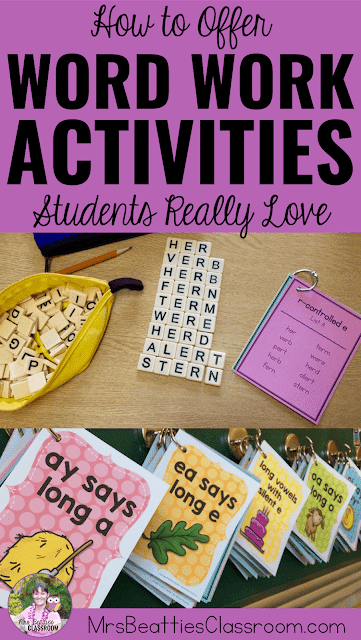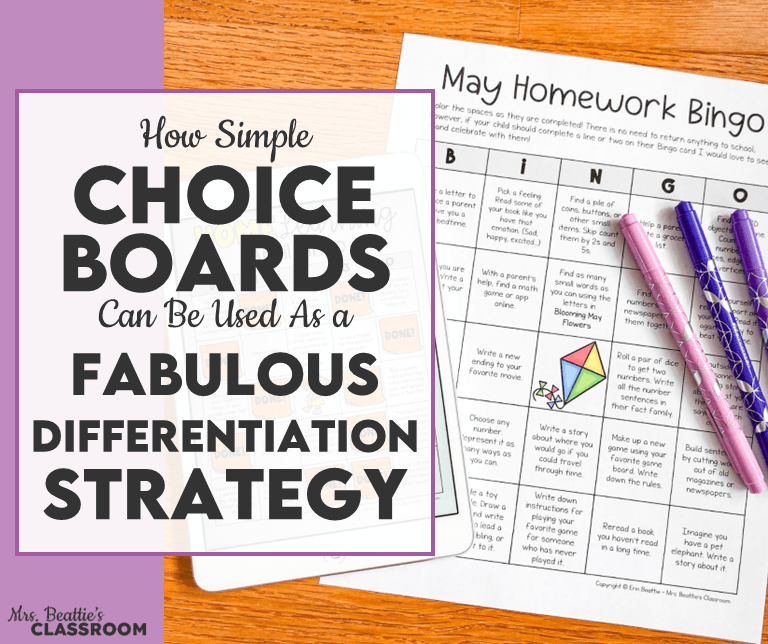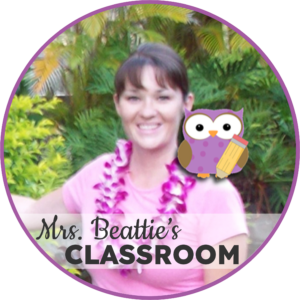It can be challenging to come up with ideas for great word work activities that meet the needs of all your students, and it may be even harder to differentiate them. Here’s the solution.
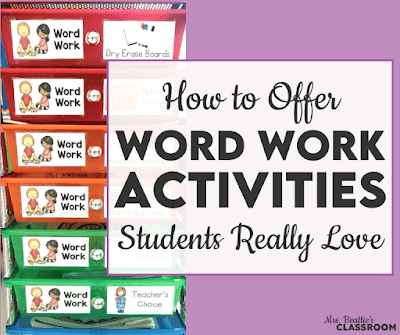
Word work is an essential component of a primary literacy program, but it can be a headache to plan for. Your classroom contains very early readers with limited skills, accomplished readers working beyond grade level, and others who find it difficult to stay engaged with anything.
The task of preparing activities can be daunting every week. How do you create activities that everyone will enjoy? How do you come up with word lists to accommodate every student? How do you do all this while still having time to plan for other subjects?
I’ve created a program that allows you to differentiate your word work component without pulling your hair out!
How to Easily Differentiate Your Word Work Activities
Differentiation is no easy task. Every classroom I’ve ever taught in has a range of abilities that spans a minimum of four grade levels. From time to time, that gap is even wider!
In my classroom, I generally organize my students into three main word work groups. Is this perfect? No. But in the short time I have for word work activities, and because I have limited planning time (and a life outside of school!), sometimes that must be enough.
I used to spend hours each week combing through a variety of old spelling resources to create word lists that were just right for all my groups. It was one of the most frustrating parts of my planning process because it felt like time wasted!
After many attempts to streamline this process, I created this simple collection of Differentiated Word Lists to pull lists from each week.

How to Get Started
I begin the school year with a Words Their Way spelling assessment to get a handle on where my students fall on the continuum. From there, I can assign them to one of the three lists: List A, List B, or List C.
I don’t give a weekly paper-and-pencil assessment to determine which list will be best for each student. We are well-educated professionals. You know your kids better than anyone. Trust your instincts. I can’t think of a single test that will make a more accurate placement decision than you will.
Choice is Powerful!
Using a Daily 5 structure in my classroom, my students and I often discuss how to pick a “Good Fit” book, and this also carries over to our word work. I often direct my students to an appropriate word list, but sometimes, they surprise me and can do more (or less) than I expect.
I trust my students and have built such strong accountability into my program that I can give them some control and flexibility over which list they use. (You can read more about this in the blog post I’ve hyperlinked at the end of this one.)
Easy Organization
I keep my lists organized by spelling strategy, although they could be organized by the student as well. I have multiple sets of the three lists attached with a small binder ring, and these hang on magnetic hooks on my chalkboard. (I’ve also seen utility boards and hooks used for this purpose.)
I don’t require a set per student since my students are not all working on word work simultaneously – this is the beauty of The Daily 5 and especially helpful when you have limited resources!
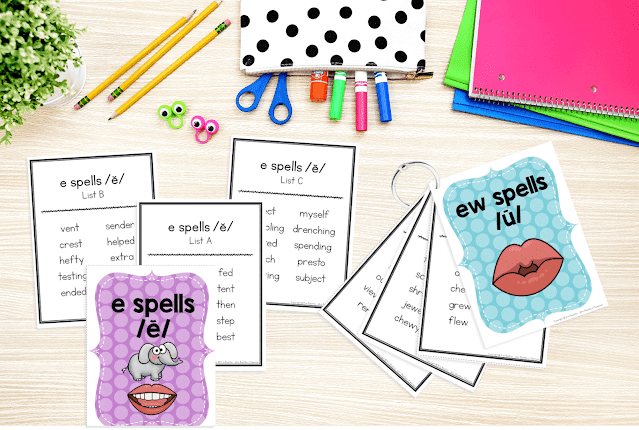
Each week, I introduce the new word work pattern, and we complete whole-group activities around it before my students head off to Daily 5. During word work, my students will grab a copy of the lists, and then activities begin.

Create Engaging Word Work Activities
In my many years of teaching experience, I’ve learned that the best activities are the ones that include manipulatives that my students can handle.
Worksheets are not the answer. Students who have worksheet after worksheet pushed under their noses become bored, disengaged, and often disruptive.
The centers that I provide to my students can be used with any list of words, making them great for differentiating discreetly. I include many options and give my students their choice over which center they work on.
Wait. You Don’t Assign Activities?!
Remember, the power of choice is huge! When students have control over which activities they use, engagement increases, and I’ve seen this year after year!
My students never feel embarrassed about working on something different from their peers because I make every word list look just like the next. Everyone is successful with the centers I’ve provided since they are simple enough that detailed instructions are not required.
Here are some of the word work activities that I use in my classroom that my students are especially engaged with:
Alphabet Stamps
I grabbed these stamps at Michaels. They were costly, but I did use a 40% off coupon! You can find them in many more stores these days, so keep your eyes open!
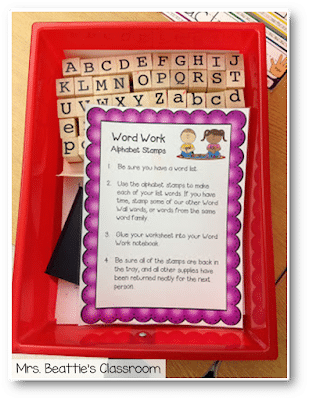
The students have been keen to use them. I understand why… I would have loved using these at school when I was a kid!
Chunk Magnets
I inherited these when I moved to my primary classroom, and they are great! A few readers have told me that they may have come from Lakeshore Learning.

Rainbow Words
A simple center to include, but this one really speaks to the more artistic students in the class. 🙂

Bananagrams
I knew this would be one of the most popular choices, and I was right! Typically, it is the first activity to leave the drawer!

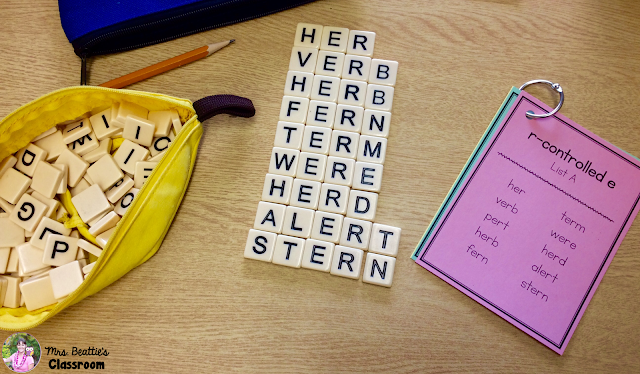

Other Options I’ve Offered:
These are some of the favorites we currently use, but my word work resource includes options for dry-erase boards, Play-Doh and Play-Doh stamps, stencils, Wikki Stix, letter beads, letter tiles, keyboarding, and Boggle.

How Does This Work With Programs Like UFLI?
If you’re using the UFLI Foundations program, you’ll find that this resource complements it perfectly. It aligns with the phonics-based approach, offering additional support to reinforce what you’re already doing with your students.
The word lists contain almost all the grapheme-phoneme correspondences in the UFLI program (beyond individual letter sounds), making them perfect for follow-up activities to your UFLI Foundations lessons!
Frequently Asked Questions:
Is keeping students engaged an issue? No! That power of choice really does provide the interest and drive that keeps students going.
Are students actually completing the activities while I’m working with other students? Yes! Be sure to check out the linked post at the bottom of this page. In it, I explain all about how I keep my students accountable for their work during independent centers.
Does this take a lot of time to prepare each week? No way! Once the centers are set up, they are good to go. I have four sets of word lists on each letter-sized page, so each week, I print four pages—yes, you read that right—attach them with the rings, and they are ready for use. I save these from year to year and only occasionally have to replace a set. I do not laminate them, although you certainly could.
Word Work Center Storage
I receive many questions about storage. I organized my centers in this great storage rack I inherited from another teacher who was purging her classroom! Score! 🙂 It is perfect for these!

How Do You Assess Student Work?
I get many questions about how I assess my students’ word work. What I don’t do is give my students tests. They are not a good use of my time and do not really tell me anything about my students as spellers.
Instead, I look for my students to use the spelling patterns they’ve learned about and worked with during their daily writing. That transfer from practice to authentic, everyday use matters to me. That’s an accurate measure of success.
If my students struggle with words they’ve already practiced, we spend time adding them to their personal dictionary/word book, and I encourage them to access the word lists throughout the day during other content writing.
Interested In Trying These?
My students are SO engaged in all parts of The Daily 5 program, but Word Work is the favorite! They love it, but I love it more!
I’ve saved you the work of creating these word lists and hands-on centers for your students. All these centers PLUS the storage labels, activity sheets, AND an editable package are available in my TpT store! Grab them here:
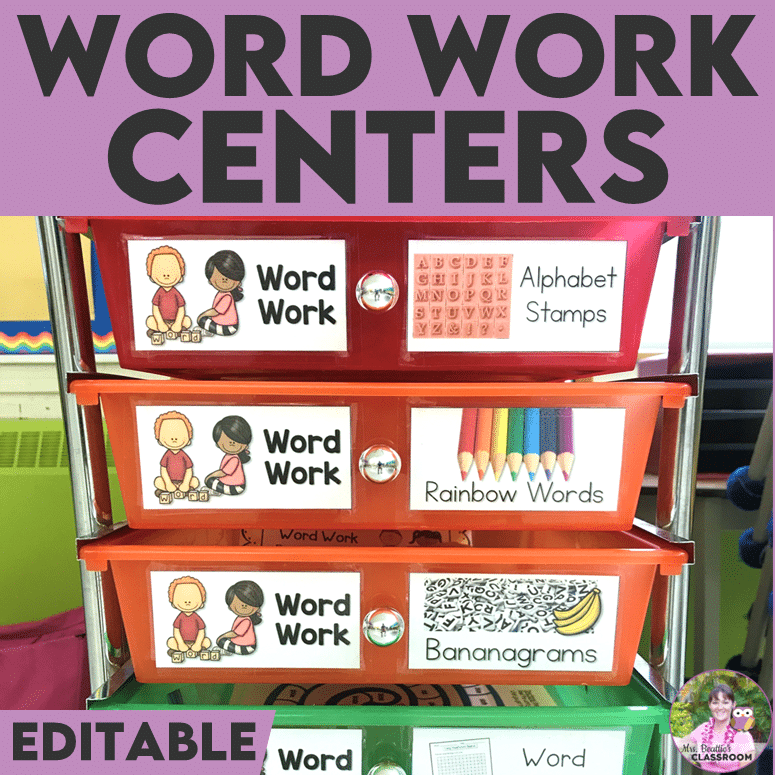
Need word lists for use with YOUR word work centers? Look no further! I have you covered in a BIG way!!
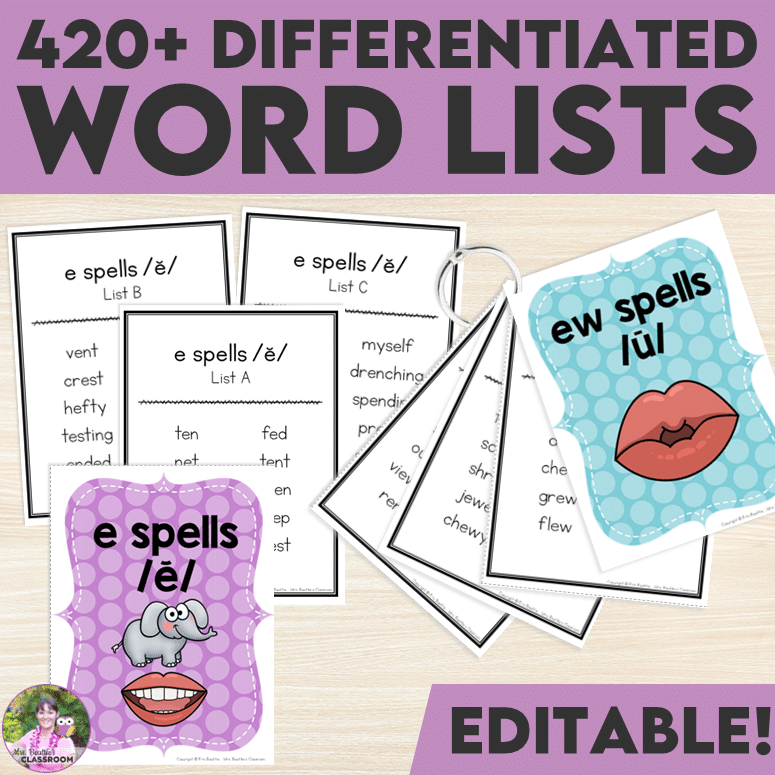
This more than 2500-page resource is easily assembled either by spelling pattern OR by student and is COMPLETELY EDITABLE!
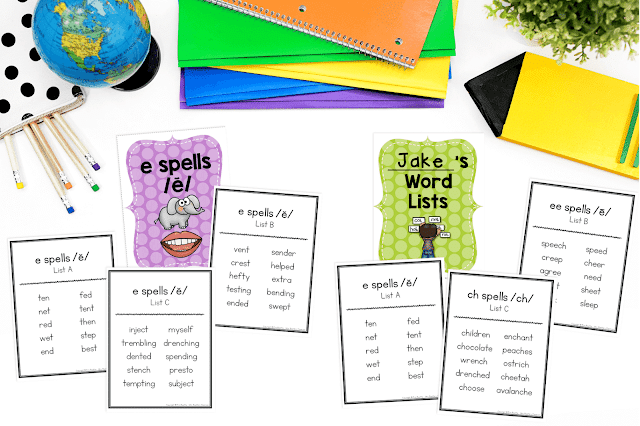
There is also a single-page printing option included! These are perfect for small-group or homeschool use!
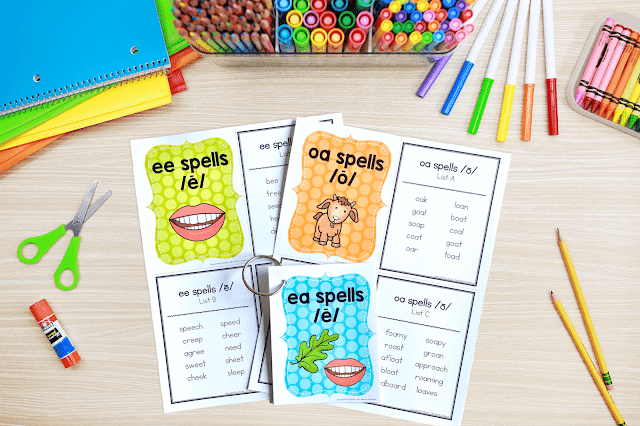

Where Does Online Teaching Fit In?
Physical distancing and online teaching have changed how we look at our classroom resources and the way they are shared, and for the time being, that will impact your hands-on word work program. There are several ways that you can adjust to account for this:
- Use individual student lists, as mentioned above, rather than shared lists on an interactive word wall.
- Provide students with printable manipulatives so they can each have their own set. You can grab a FREE set of upper and lower-case printable letters right here:

- Save yourself a ton of time and provide your students with a digital word work option like the one below:

During the challenging time of online learning, I added a digital word-building resource to my Teachers Pay Teachers store that students can use in Google Slides! You can access that here:
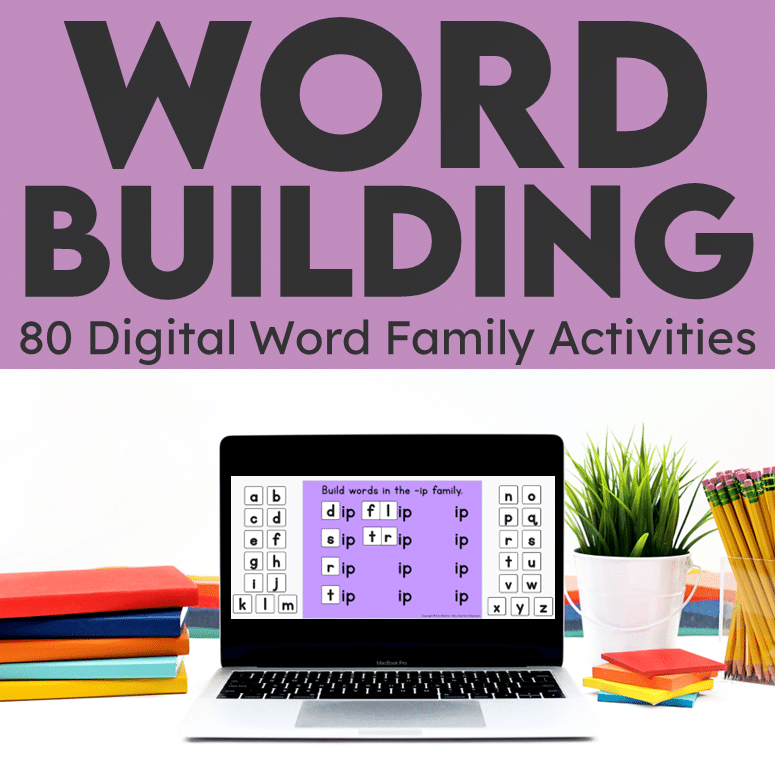
What Actual Teachers Are Saying About These Resources
These two-word work resources have been available in my Teachers Pay Teachers store for several years and have been widely recognized by real teachers like you!
Kimberly says this about the Differentiated Word Lists:
AMAZING!!! I have been searching high and low for a product that has 3 separate lists and these lists are spot-on perfect! You do not even know how much time that will save me. Thanks you!!!!
Shawn has this to say,
OMG – LOVE LOVE LOVE THIS!!! It has changed the way I do spelling. My kids love it too. Cannot say enough GOOD about this!
And about the Word Work Centers, Ruth says,
Absolutely fabulous. The detail in this is amazing. I love the way you have made it so open-ended that it can be applied to any word list. This is all done for you. so much time and planning already done. You are clever! Thank you!
Interested in trying these word lists for FREE? Join my mailing list, and I’ll send you some as a thank-you!

Are you using The Daily 5 and CAFE in your classroom? What does your word work program look like? I would love to hear how it is going. Leave me a message at the end of this post!
You might also be interested in this blog post about keeping your students accountable during center work:

Pin this post!
